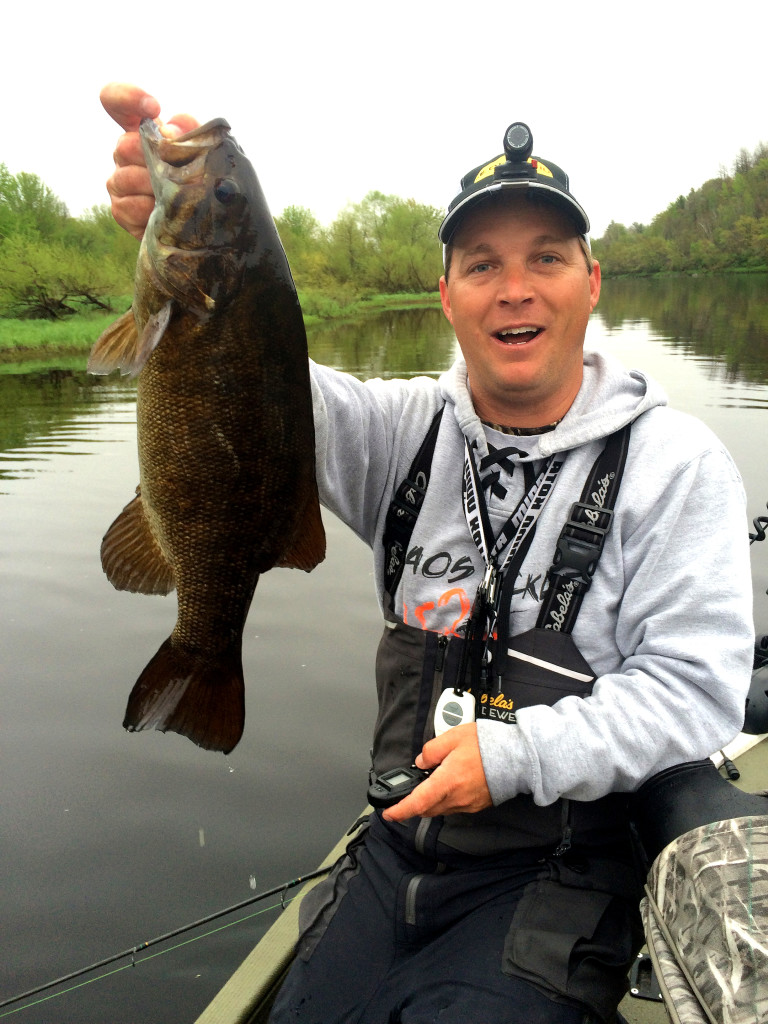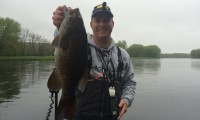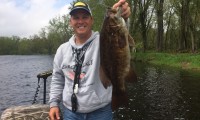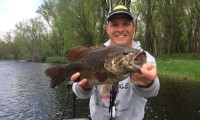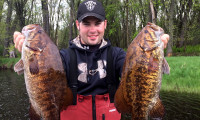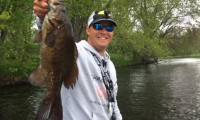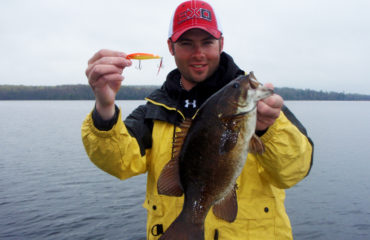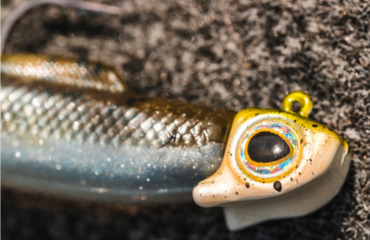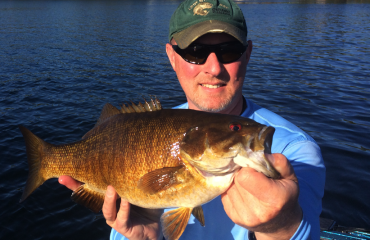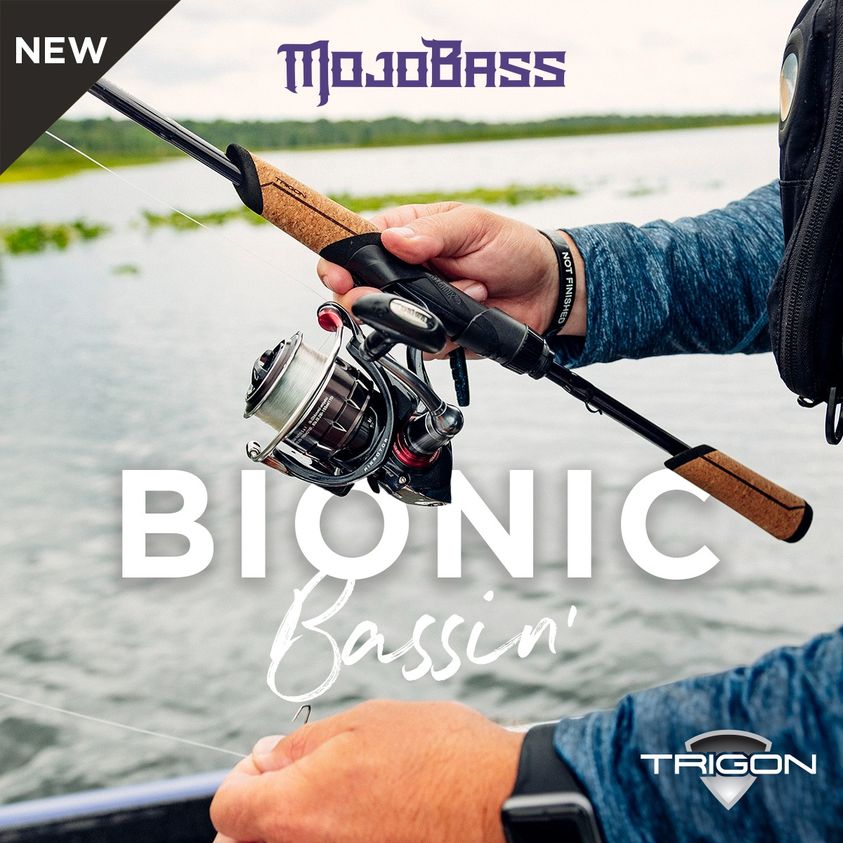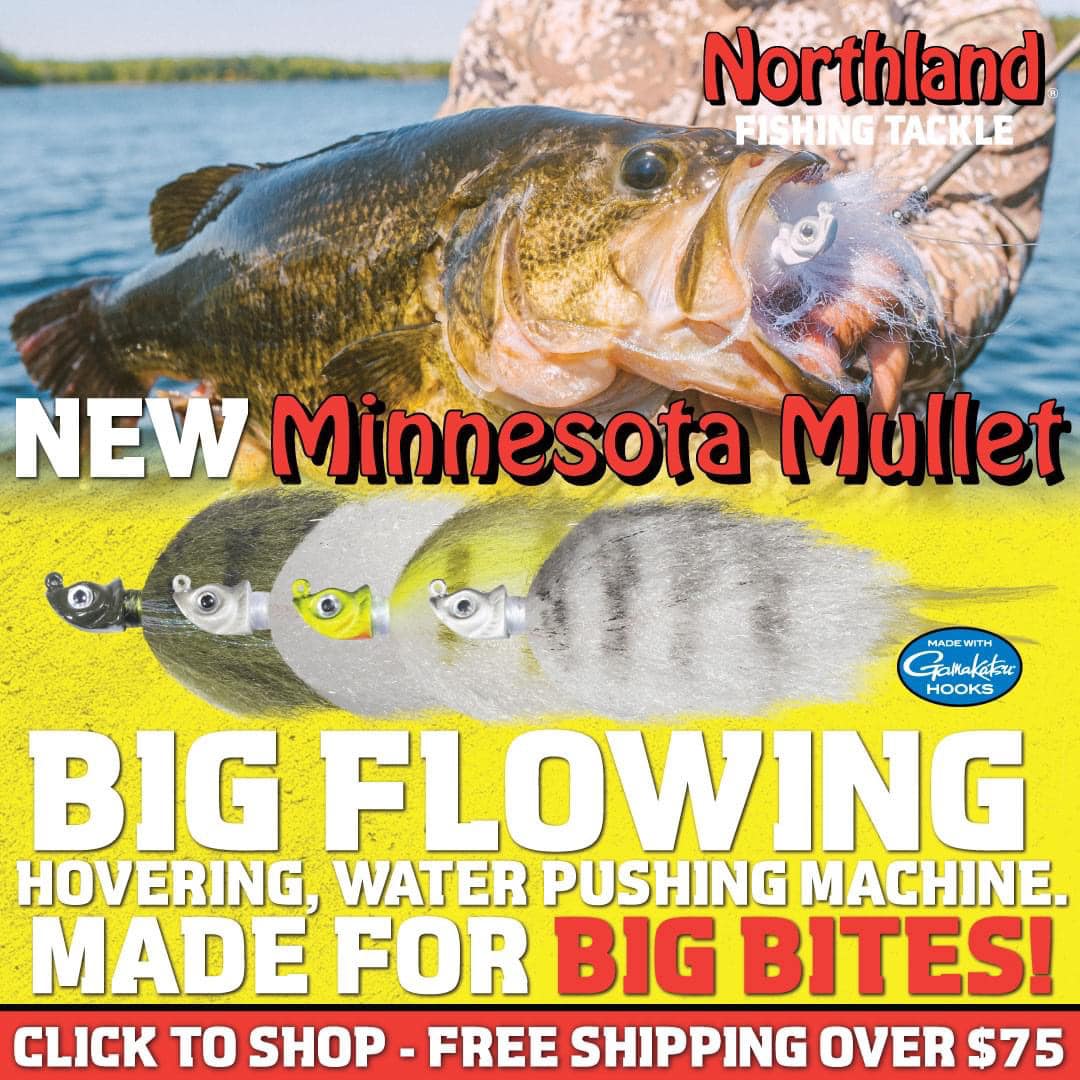On The Jets For Wisconsin River Smallmouths
By Andrew Ragas
Regarded as America’s hardest working river for its elaborate dam usage and flowage systems, the Wisconsin River is a boating minefield whose smallmouth bass fishing is best experienced with a jet boat. Aboard with Central Wisconsin River guide, Kurt Schultz, smallmouth bass fishing of world class proportions is a reality.
The Wisconsin River is well known for producing abundant, under fished populations of trophy smallmouth bass. As it begins at its headwaters of Lac Vieux Desert on Michigan’s U.P. border, resembling more of a large creek that winds its way through the wild northern wilderness of Wisconsin, the character of the river changes considerably the further downstream it’s traveled.
The Wisconsin River is a boating and wade fishing minefield. It’s a paradise for river smallmouths, but pending death grounds for boats. Anglers willing to accept its challenging terrain and difficult navigation don’t mind. With treacherous navigation present, rugged jon boats powered with jet drive outboards are the most ideal watercraft for most Wisconsin River angling scenarios. Wausau, WI resident and licensed fishing guide, Kurt Schultz, best exemplifies this adaptation to fish and annually succeed on these treacherous waters, where few others are ever able to do so with regularity.
Schultz, 35 (www.kurtsguiding.net), has been a licensed fishing guide on the Central regions of the Wisconsin River since 1999. His passion for the Wisconsin River fishery began while as a young boy, growing up in the 1980’s, where he spent nearly every free hour on the river learning the trades of someday becoming a river rat and making a living from its resources. Today, Schultz runs over 180 guide trips per season, specializing in muskies, bass, pike, walleyes and panfish.
Schultz is better known as a muskie fishing guide. However, he openly admits to having a fiery passion for big river smallmouths, which is the best game in town from spring through mid summer.
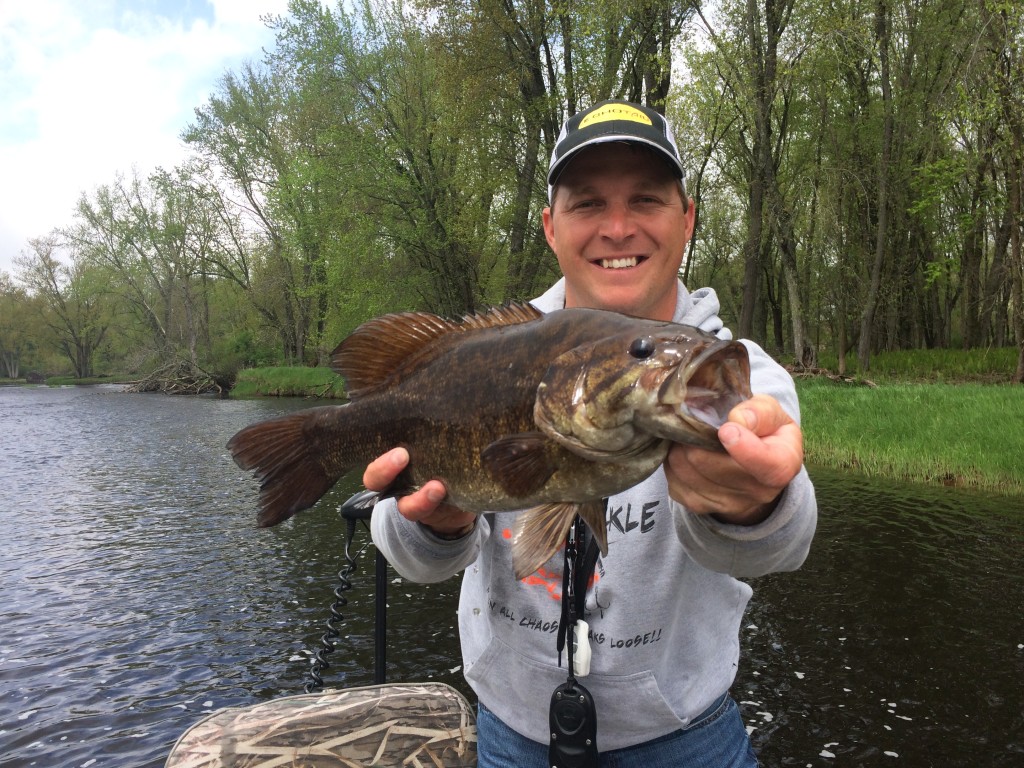
The Wisconsin River Fishery
The allure of Wisconsin River smallmouth fishing is the result of natural river habitat that hasn’t been influenced or degraded by man. Combined with little fishing pressure and difficult to navigate miles of river that isn’t floated by boat or fished often, an amazing bass fishery sustains itself.
I joined Schultz on a mid-May, 2015 morning and afternoon in the Central Wisconsin region, on a stretch of virgin river comprised of rock fields and boulders, islands and oxbows, and log jams. It was an ideal wilderness setting, typical for the wild Wisconsin.
We fished in midst of the spring spawning period as water temperatures were in the 56 to 60 degree range. We both knew that when located, these fish would be packed in their spawning areas and heavily concentrated.
“There is an abundant population of smallmouths in the Wisconsin River from where it begins in northern Vilas County, all the way south to the confluence of the Mississippi River,” says Schultz. During spring, the population density shows, as do numbers of bigger fish. As the spawning season progresses into the post-spawn and summer phase, fish disperse and the game grows tougher. “At this time in mid summer, fish are more scattered. There are certain stretches that will hold a lot of bass, but there’s a lot of dead water in between,” he says. “Big bass can be caught all throug summer and into fall, but the key at this time is to cover water and work as many different spots as you can,” he concludes.
During our eight hours of fishing together, floating five miles of river, and learning from one another as fellow river rats, Schultz and I had a good day of fishing despite facing post-frontal conditions and a pending coldfront. Approximately 30 smallmouths were boated, with average size recorded at 18”, and the largest being a handful of specimens up to 20.5”. Is this good enough to be considered a world class inland fishery?
According to Schultz, whose largest Wisconsin River smallmouth to date is a 6.2 pounder, measured at 22 ¼ inches, “A great day of fishing the river can produce up to 40 to 50 bass ranging from 14 to 21 inches.” These high catch rates are most common in spring as fish are migrating upstream and holding in the river, and then again in autumn as fish begin schooling together in their downstream wintering holes located in the flowages. Meanwhile, a tougher day of fishing can yield 10 to 15 bass within the same size range.
Schultz admits that if you are new to the Wisconsin River, your first few outings may be trying times. “Every minute you spend on the river, whether catching bass or simply navigating it, you should be learning things,” he says. What sets Schultz apart from most river anglers is his ability to process information, and retain the knowledge learned from over 20 years of river fishing experience. “I have become a great river angler because of all the times I’ve spent on this water, catching nothing,” he says. When Schultz catches fish, he analyzes how it was caught, and why it struck his lure. It enables him to figure out their patterns, and find their locations.
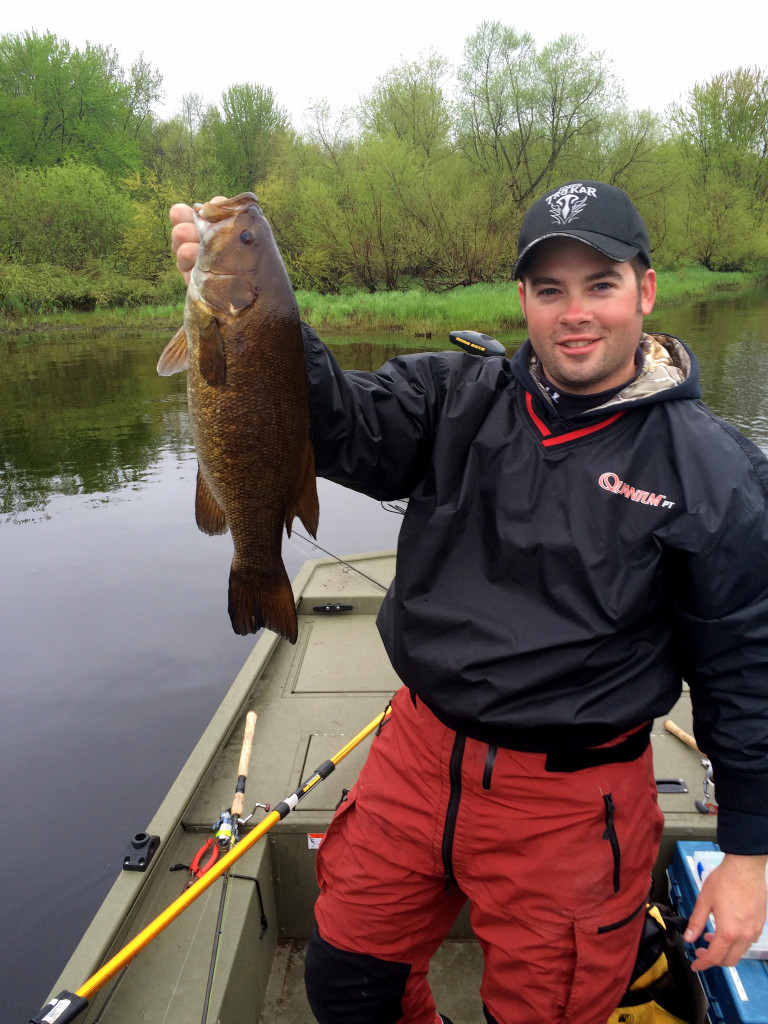
In order to approach fish best in spring, Schultz and his clients will start the season fishing in the vicinity of spawning sites, looking for shallow, calmer hard bottom waters in depths ranging from 3 to 10 feet. Such areas are stumps, shoreline pockets, mid-river eddies, the downstream pools of islands and oxbows, and current breaks that include boulders and log jams.
Locations and River Movements
The Wisconsin River is ready for bass fishing as soon as the ice flows melt away in April, and bass migrate from their wintering holes into the main stems of the river for feeding followed by spawning. “Bass will travel up to 15 miles or more, and I’ve witnessed this,” describes Schultz.
“The smallmouth bass spawn, like most other river species, is different in every pool of the Wisconsin River,” Schultz says. “I’ve observed the spawning period start as early as mid April, and some years it doesn’t happen until late May or early June,” he adds. “It all has to do with climates, weather patterns, stream flow rates, and water temperatures,” he concludes.
Schultz follows a springtime biologic calendar, and applies it for his decision-making and execution. Each spring season differs, thus the key to any spring smallmouth movement and the trigger for spawning all correlates to the ice-out schedule and climbing water temperatures.
Due to ice jams, current, and water level fluctuations, the channels and depth of pools are always changing. Because of this there aren’t any suitable navigational maps for the Wisconsin River to aid anglers in locating spots. The process of finding fish is a hands-on approach for Schultz, as he uses his Humminbird 898 with side-imaging to find underwater structure, and his eye-sight and visual cues for identifying and reading the river. “I will spend hours driving upstream and downstream, through the channel and along shorelines, marking depths and adding waypoints onto my Lakemaster GPS chart,” he says. Schultz stresses, “It is best to do mapping in spring when weedgrowth is down so the bottom can be marked clearly. If you are not equipped with a locator, the next best thing is to look for trees along shore that have fallen in or rocky shorelines as they will extend into the channel, and the presence of rusty crayfish. See them on shore, bass are not far away!”
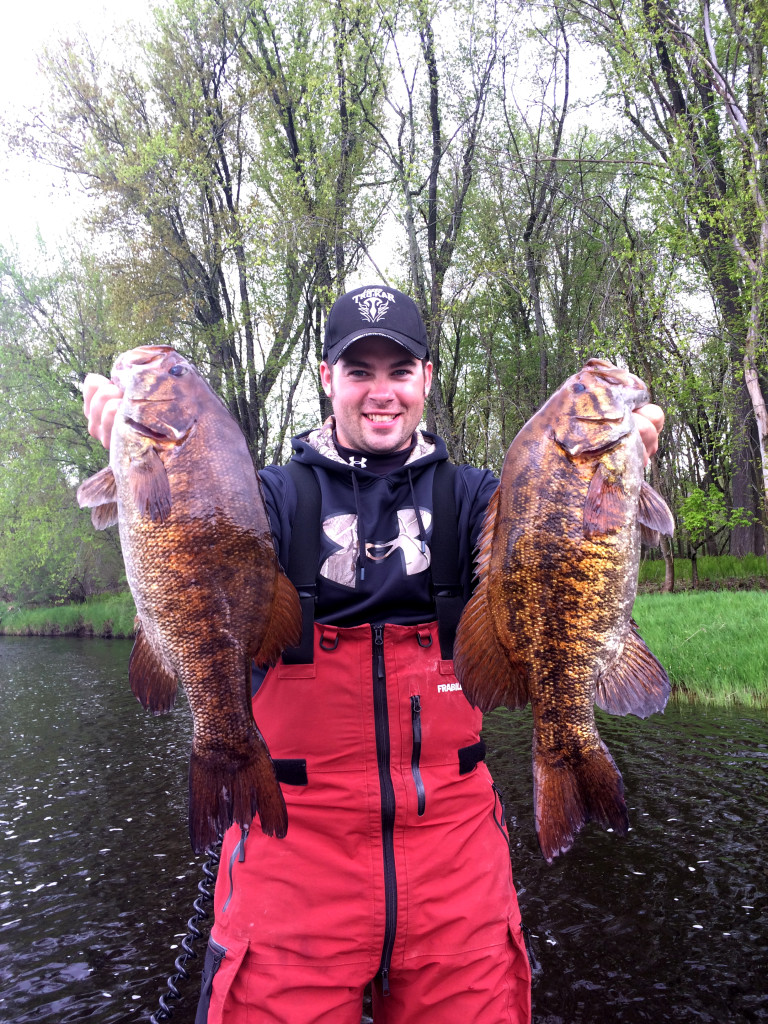
The author, with a pair of 20.5 inch specimens. Both were caught at the same time on tube jig and sucker minnow with Schultz.
The process of locating and catching river smallmouths relates to their habitats, migrations, and the angler’s ability to determine good locations. “When I go out and search for smallmouths, I cover as much water as I can each day,” says Schultz. A typical daily float for Schultz and his clients will run anywhere between 2 to 6 stream miles. “Once I locate one bass, I know a wolfpack of others will be nearby,” he says with a sly smile.
In order to approach fish best in spring, Schultz and his clients will start the season fishing in the vicinity of spawning sites, looking for shallow, calmer hard bottom waters in depths ranging from 3 to 10 feet. Such areas are stumps, shoreline pockets, mid-river eddies, the downstream pools of islands and oxbows, and current breaks that include boulders and log jams. “We usually position a long distance from shore, bombing long casts to reach these fish,” he says. Once fish conclude with spawning and disperse throughout the river, covering water with search baits is the way to go. If good structure and habitat is located and fished in summer, “You will find bass on the Wisconsin,” concludes Schultz.
Besides spring and summer, fall is a period for big fish. “In fall when water levels drop, and the cold nights lower water temperatures, the majority of the bass are migrating downstream into their flowages and deep main river channels for wintering, he says. At this time, Schultz looks for deep water with minimal current and any type of rock humps and structure that will hold fish.
Watercraft and Strategies
To get to his best spots, Schultz relies on his armada of Lowe Roughneck Jon Boats. He runs two models, an 18ft Roughneck with a 90/65 Mercury jet, and a smaller 17ft Roughneck with a 60/40 jet. Each is able to comfortably handle up to 3-4 people per trip. He runs jet drive because he’s often navigating through depths shallower than 2 feet, with lots of hazards. The jet boat makes life easy for river navigation, offers safety for all guests who are aboard, and gets Schultz around everywhere.
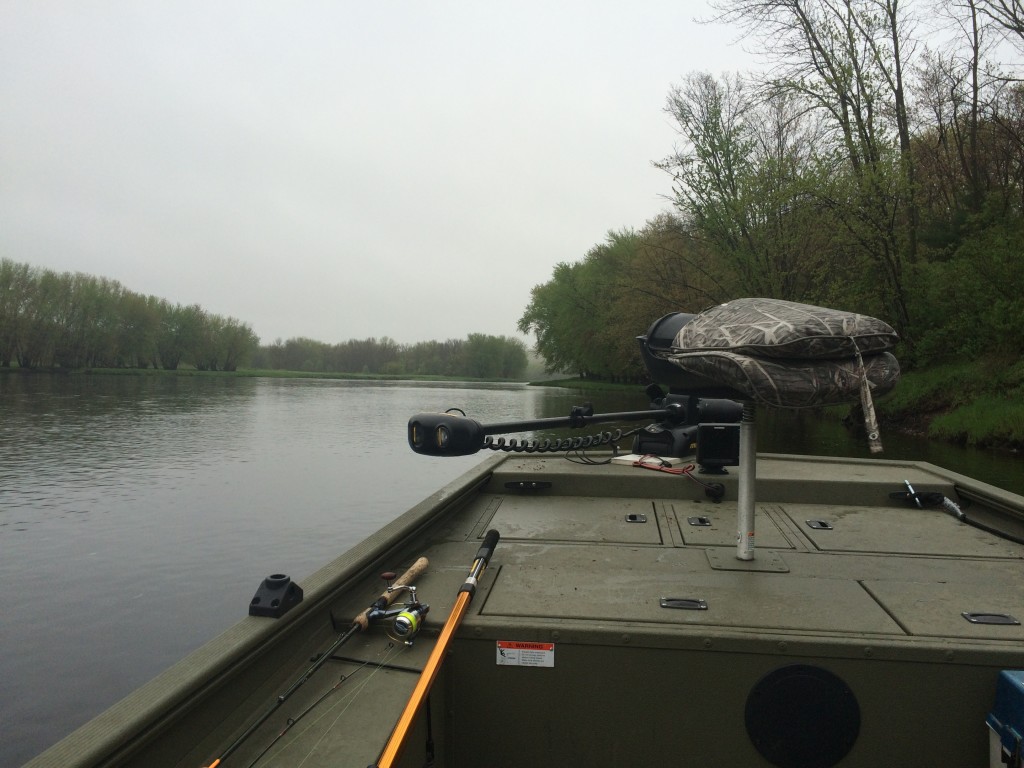
Schultz fishes with a fleet of Lowe Roughneck semi-v flat bottom jon boats. Due to obstacles and shallow waters, jet drive outboards are the best way to navigate at high speeds.
“I’m able to get into spots and pools of the river that most anglers will never be able to get into with traditional watercraft,” he says. “On most stretches of the Wisconsin River you will not need a jet drive, but there are a lot of stretches of river, especially the further north you go, where it is a must-have.”
When fishing shallow rivers such as the Wisconsin, good boat control is the most important tool. The two most important items in Schultz’s Roughneck are his MinnKota Terrova 80 wireless trolling motor and MinnKota Talon. “The Terrova holds me in position with the spot lock, and when positioned upstream slows me down so that I’m not speeding by all the hot spots,” he says. Besides the Terrova, his Talon drops and holds his boat in position, regardless of strong current. “The Talon is not only a great anchor, but it saves on my back!” he exclaims.
“When I take my guests fishing, they normally don’t realize how much work is being done to maintain precision boat control. They are on my decks, casting, and enjoying their day; that is how it’s supposed to be. The technology we have nowadays with electronics, trolling motors and anchoring systems makes my job so much easier and efficient,” he says. Helping his boat catch more fish, and to fish efficiently, is what these accessories are all about.
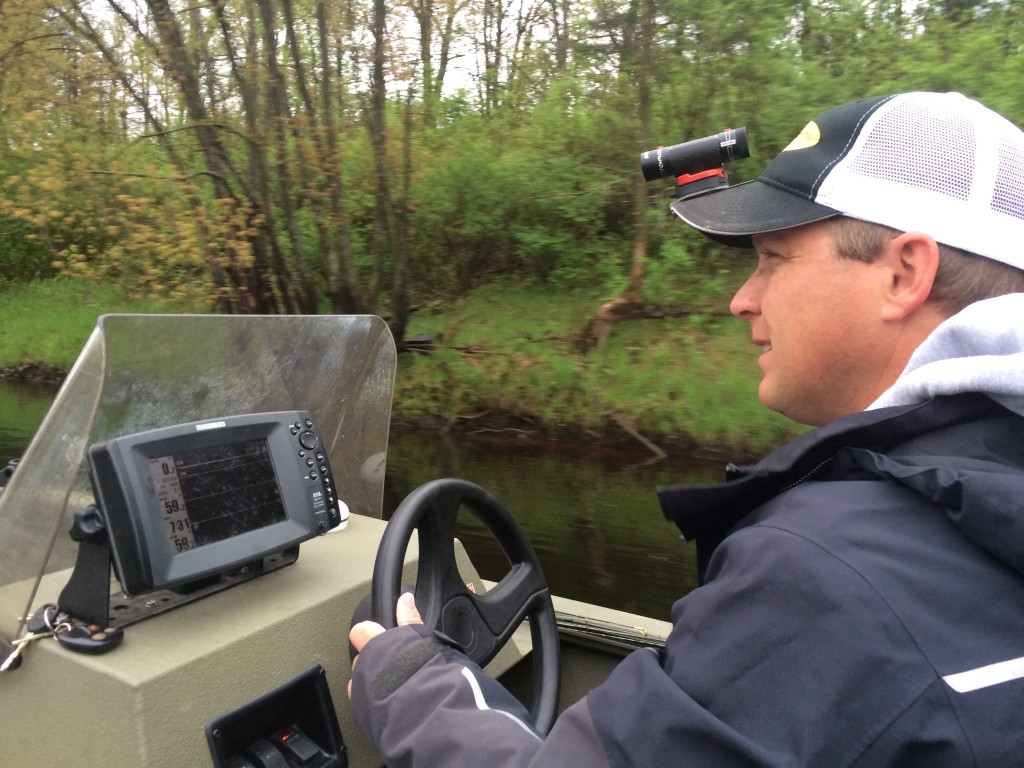
In order to best fish the Wisconsin River, Schultz keeps his lure selection simple and basic. He’ll let the season dictate what to use. “All you need is a good spinnerbait, a handful of shallow to medium diving crankbaits in red craw pattern, an assortment of walk the dog and popper topwaters, and a handful of assorted soft plastics such as tubes, hula grubs, and stick baits,” he admits. “Keep it simple, you don’t need 50 different lures. If one bait is working, keep fishing it and don’t change the approach.”
On our float, I found a variety of my river standbys to work on Schultz’s water: Jonn Graham’s Warrior Swim Jigs, Freedom Lures Spinnerbaits, Chompers Hula Grubs, Rapala X-Rap Pop and Skitter Walk topwaters, Strike King Coffee Tubes, and Stankx Bait Company’s 4.25” Jerx.
Schultz offers some tips below:
SPRING
When it’s cold in spring, one overlooked approach Schultz succeeds with is the use of a topwater. “Most guys will never work a topwater at this time,” he says. Every season, some of Schultz’s biggest fish are enticed by topwaters when water temperatures are in the 40’s. As these staging fish move in closer to their spawning sites, soft stick baits, tubes, flukes, sweet beavers, and twin tail grubs get fished a lot.
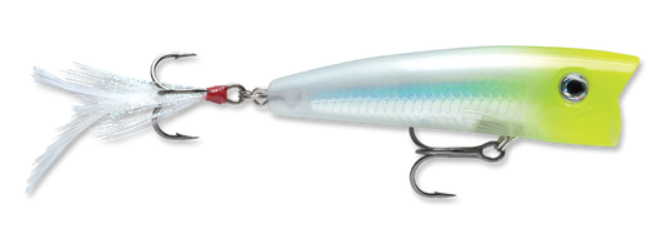
Rapala X-Rap Pop
If smallmouths will not strike an artificial in spring, Schultz will drift slip bobber rigs with large 4-6 inch sucker minnows using either 4/0 Gamakatsu Octopus or circle hooks. “Big smallmouths that are on their beds cannot stand a live minnow swimming around their nests, thinking it will rob their eggs.” Schultz demonstrated this to me by catching a trio of 20 inchers. Schultz uses this set-up for beginner anglers who may not be the most skilled at casting or presenting artificial lures, and even as a last resort. “The goal every day is to catch fish, no matter what it takes,” he says laughing.
SUMMER
Once smallmouths move off their beds, “I use a lot of double willow and double Colorado spinnerbaits to cover a lot of water as fish will be spreading out. Once I find their holding areas, I will then use chatterbaits, tubes, stickbaits, and topwaters,” he says.
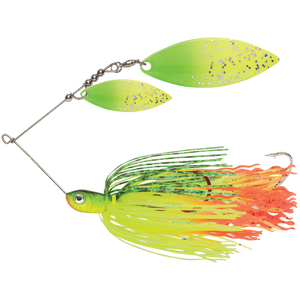
Northland Reed Runner Spinnerbait
FALL
As water temperatures cool, location has more precedence over lure choice. You must find where the bass have migrated to for their overwintering. Slow your presentation down with a jig and pig, tube jigs, and weighted stickbaits.
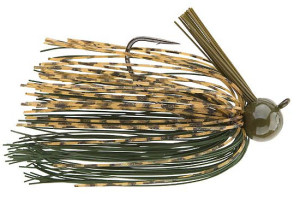
BOOYAH Pigskin Jig
Schultz, a staffer with Wisconsin-based Tooth Tamer Rods, recommends medium heavy action rods for all river fishing applications. His preference is an all-purpose 7ft. 2in. medium heavy action Tooth Tamer spinning rod with size 30 reel spooled with 15 to 20lb braided superline. With this type of a setup, his bass clients are able to withstand fighting fish with powerful currents, and they simply get fish into the net.
Free The Fighter
With an inland fishery of world class proportions come the responsibilities of state management and maintenance. For the most part, Wisconsin has done a good job in maintaining and expanding this self-sustaining fishery. “While fishing these waters every day, it is amazing how well catch and release on the Wisconsin River works,” says Schultz. “I have been catching big fish year after year. The most rewarding catch is the big old fish with battle scars that gets caught repeatedly.”
Schultz says there are certain stretches of river that have bigger fish in them, and he believes this is the result of the open spring season (south of HWY 10) and harvest. “At times I will see bank anglers with stringers of 18 to 21” bass,” he says. If the Wisconsin River had a spring size restriction or a closed catch & release season like the north, Schultz and I believe it would greatly help this fishery for sure, and keep the largest fish in the system.
To schedule a trip with Kurt Schultz, who often gets booked early, it’s best to inquire 2 to 4 weeks in advance to request a desired date to fish with him. Not only will anglers catch fish with Schultz, but they will learn about river fishing strategies, and how to fish the Wisconsin River. Best of all, it’s a beautiful float trip in which you won’t be seeing another boat fishing for miles! Kurt Schultz can be reached by telephone at (715) 571-7132, e-mail ksguiding@gmail.com, and on the web at www.kurtsguiding.net




